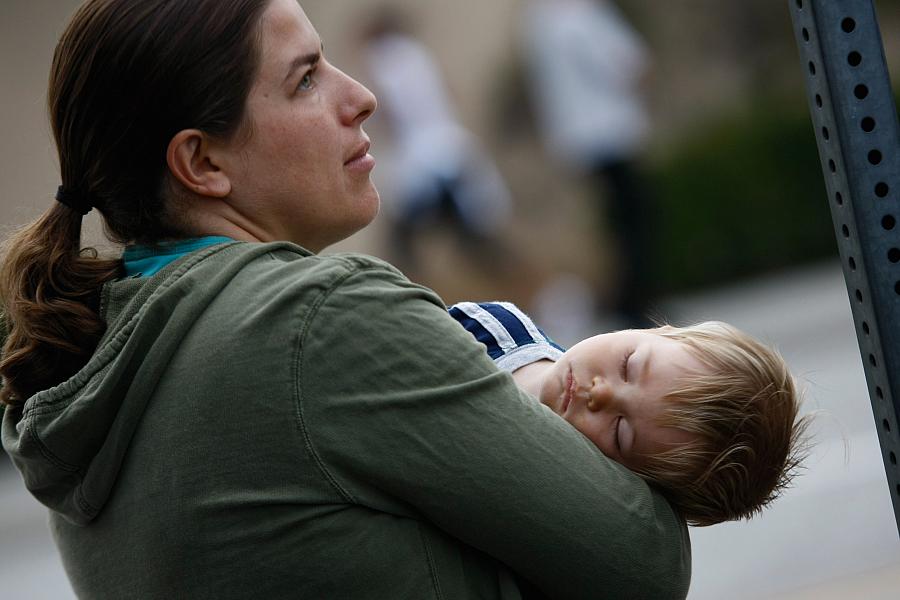What works to boost children's health insurance? A tale of two states

An uninsured mother and her son wait at a free health clinic in Inglewood, California.
(Photo by John Moore/Getty Images)
Why is the number of uninsured children in the United States rising?
A report released late last year by the Georgetown University Health Policy Institute posited that it was caused by the unsuccessful effort to repeal the Affordable Care Act, the delay in renewing funding for the Children’s Health Insurance Program, and anti-immigrant rhetoric from national politicians.
But a look at how the country’s two biggest states have insured their kids further illustrates why nearly 4 million American children remain without health coverage.
“Texas and California make this interesting case study where it’s clear where politicians decided to go and what those consequences were,” said Shana Charles, an assistant professor of health science at California State University at Fullerton.
California, with nearly 40 million people, has a youth uninsured rate of 3.1 percent, the 12th lowest in the nation, according to the Georgetown report. The second-biggest state, Texas, which has 28.7 million residents, has the highest percentage of kids lacking health coverage: 10.7. That means more than a fifth of the nation’s uninsured children live in the Lone Star State.
And while Texas’s youth uninsured rate rose from 2016 to 2017, California’s percentage stayed the same. Nationally, the rate increased from 4.7 to 5 percent.
So how did the two states diverge?
A big reason is that California worked aggressively to implement the Affordable Care Act, while Texas did not, health policy experts say.
Unlike Texas, the Golden State embraced the law’s Medicaid expansion, simplified eligibility verification for that program, and set up a state insurance exchange, called Covered California. Since 2008, two years before Obamacare passed, California's youth uninsured rate has fallen by more than two-thirds (though Texas’s also dropped from 17 percent that year to 10.7 percent).
“We’ve spent significant funds on outreach and enrollment,” said Deborah Kelch, executive director of the Sacramento-based Insure the Uninsured Project. “There’s a huge amount of attention placed on getting coverage.”
California has gone beyond the Affordable Care Act in its effort to insure kids. The state extended coverage to foster children until the age of 26, and, perhaps most significantly, provides Medicaid insurance to undocumented children and teens (Texas does not do this).
And California has also bucked recent national policy, maintaining its exchange enrollment period and investing money for marketing and outreach when the Trump administration slashed both.
“California has had bipartisan support for the past few decades in basically taking advantage of every public program to cover kids,” Charles said. “It’s been a point of consensus that kids should not go without coverage — it’s not their fault.”
She acknowledged, however, that California is a wealthy state — it has the fifth-largest economy in the world — with a lot of foundation money, and that smaller, poorer states may have a harder time affording coverage for kids.
Even before Obamacare, Texas led the nation in uninsured children.
“Texas has for a long time not implemented many of the best practices that we know help reach and enroll eligible children,” said Laura Guerra-Cardus, deputy director for the Children’s Defense Fund in Texas.
That includes not giving continuous coverage for an adequate period of time to kids on Medicaid, she said. Medicaid recipients in the state stay enrolled for six months, but then must have their income verified every month in the second half-year period. This can make things difficult for Texans with nontraditional employment, such as contract or seasonal work, or self-employment.
“Anytime you create another moment where families have to interact with the system, the chance that children will fall through the cracks increases significantly,” Guerra-Cardus said. “They might get letters late, they might have moved, the database might have old information — the light goes on.
“This becomes even more problematic when the child has a serious care issue. A family we’re working with right now the child has cancer.”
She said research has found that adults who had Medicaid as children are more likely to succeed in school, earn more money and be healthier than those who didn’t have coverage. “If a child in uninsured, a parent may choose to delay care. When they seek care, it’s often in most expensive setting, in the emergency room,” she said.
Legislation in the Texas Legislature is trying to change eligibility verification for its Children Health Insurance Program to once a year.
She said other states also do “express lane eligibility,” or using eligibility findings from other government programs to verify Medicaid benefits. Some states have schools pass along information on health coverage to students.
“There’s more we can do with state-level policy to reach children and keep them enrolled,” Guerra-Cardus said.
But California hasn’t been immune from problems affecting the nation. The state health exchange saw a drop in new enrollees of nearly 24 percent during the most recent enrollment period with the most significant decreases among people speaking foreign languages.
Undocumented adults may be leery of seeking public insurance, even for their kids, because of a proposed Trump administration “public charge” rule that would base green-card status on the likelihood of the person using government benefits in the future.
If that rules goes through, 741,000 fewer Californians will enroll in the state’s Medicaid program, 70 percent of them children, according to an estimate from the UC Berkeley Center for Labor Research and Education.
Joan Alker, executive director of the Center for Children and Families at the Georgetown University Health Policy Institute, noted that for the first time in the eight years she’s been doing her report, no state had a significant decrease in its rate of uninsured children.
“To see all states not be able to make progress means even the most well-intentioned states cannot fight these negative national currents,” Alker said.

